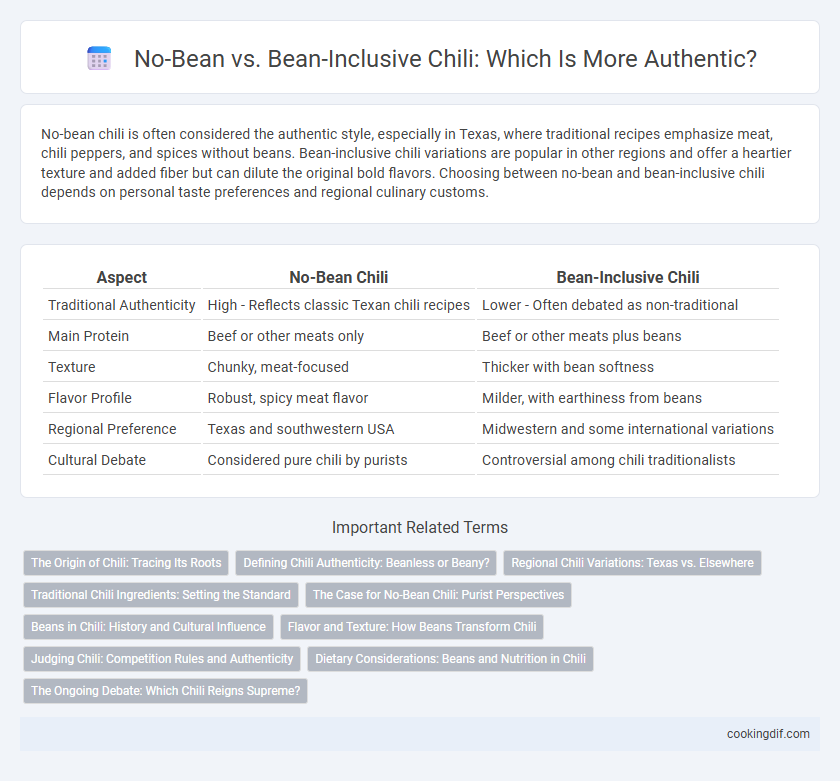No-bean chili is often considered the authentic style, especially in Texas, where traditional recipes emphasize meat, chili peppers, and spices without beans. Bean-inclusive chili variations are popular in other regions and offer a heartier texture and added fiber but can dilute the original bold flavors. Choosing between no-bean and bean-inclusive chili depends on personal taste preferences and regional culinary customs.
Table of Comparison
| Aspect | No-Bean Chili | Bean-Inclusive Chili |
|---|---|---|
| Traditional Authenticity | High - Reflects classic Texan chili recipes | Lower - Often debated as non-traditional |
| Main Protein | Beef or other meats only | Beef or other meats plus beans |
| Texture | Chunky, meat-focused | Thicker with bean softness |
| Flavor Profile | Robust, spicy meat flavor | Milder, with earthiness from beans |
| Regional Preference | Texas and southwestern USA | Midwestern and some international variations |
| Cultural Debate | Considered pure chili by purists | Controversial among chili traditionalists |
The Origin of Chili: Tracing Its Roots
Authentic chili traces its origins to Texas in the late 19th century, where the dish traditionally featured a stew of beef, chili peppers, and spices without any beans. Early chili con carne recipes from Texan chili stands emphasized meat and chili peppers, as beans were considered fillers that diluted the bold flavors. This beanless approach remains a hallmark of true Texas chili, distinguishing it from regional variations where beans are incorporated.
Defining Chili Authenticity: Beanless or Beany?
Authentic chili is traditionally defined by its emphasis on meat, chili peppers, and spices without the inclusion of beans, reflecting its origins in Texas cowboy cuisine. While bean-inclusive versions are popular in other regions and provide added texture and flavor, purists argue that true chili must exclude beans to maintain its distinct, savory profile. This debate centers on regional culinary heritage and the preservation of chili's original identity as a hearty, meat-centric dish.
Regional Chili Variations: Texas vs. Elsewhere
Texas chili, known as "chili con carne," traditionally excludes beans, emphasizing a rich blend of beef, chili peppers, and spices for an authentic flavor profile. In contrast, chili recipes from regions outside Texas, such as Cincinnati or the Midwest, often incorporate beans for added texture and heartiness, reflecting regional preferences and culinary influences. This divergence highlights how geography shapes chili authenticity through ingredient choices and cooking methods.
Traditional Chili Ingredients: Setting the Standard
Traditional chili recipes emphasize core ingredients like beef, chili peppers, garlic, onions, and cumin, establishing a clear benchmark for authenticity. The presence of beans is a contentious point, with purists asserting that authentic chili excludes beans to maintain its distinct texture and flavor profile. Regional variations, especially in Texas, reinforce the no-bean standard, setting a rigid guideline for what constitutes traditional chili.
The Case for No-Bean Chili: Purist Perspectives
True chili purists argue that authentic chili con carne contains no beans, emphasizing the traditional Texas-style recipe centered on meat, chili peppers, and spices. The absence of beans preserves the dish's original texture and flavor profile, allowing the robustness of ground beef, cayenne, and cumin to dominate. This no-bean approach aligns with historical cookbooks and competitive chili cook-offs where purity of ingredients defines authenticity.
Beans in Chili: History and Cultural Influence
Beans in chili have a complex history tied to regional and cultural variations, with traditional Texas chili typically excluding beans to emphasize meat and chili peppers. Mexican and Southwestern recipes often incorporate beans, reflecting indigenous agricultural practices and local tastes. The debate over beans in chili highlights broader cultural influences and evolving culinary identities in chili preparation.
Flavor and Texture: How Beans Transform Chili
Beans add a creamy texture and mild earthiness to chili, balancing the rich, spicy meat base and enhancing the overall mouthfeel. In contrast, no-bean chili offers a thicker, meat-focused texture with a more intense, concentrated flavor profile, emphasizing traditional Texan roots. Including beans creates a layered complexity, softening the heat and introducing a hearty element that transforms chili into a comforting, well-rounded dish.
Judging Chili: Competition Rules and Authenticity
Judging chili in competitions often hinges on strict authenticity rules that distinguish no-bean chili from its bean-inclusive counterpart, with many chili cook-offs like the Terlingua International Chili Championship mandating chili to be made without beans to preserve traditional Texan recipes. Authenticity criteria require competitors to use specific cuts of meat, such as beef chuck or brisket, alongside chili peppers, spices, and seasonings, excluding fillers like beans and pasta that alter texture and flavor profiles. These regulations ensure a standardized evaluation focused on flavor complexity, consistency, and adherence to the cultural roots of chili-making, highlighting the purist stance in competitive chili preparation.
Dietary Considerations: Beans and Nutrition in Chili
Chili recipes vary significantly in bean content, with traditional Texas chili often excluding beans to highlight the meat's flavor, while other versions incorporate beans for added nutritional benefits such as fiber, protein, and essential minerals. Including beans enhances dietary fiber intake, supporting digestive health and providing a plant-based protein source that can complement the meat protein, making the dish more balanced and nutrient-dense. For individuals with specific dietary restrictions or preferences, choosing between no-bean and bean-inclusive chili affects nutrient composition and satiety, influencing overall meal planning and nutritional goals.
The Ongoing Debate: Which Chili Reigns Supreme?
Authentic chili recipes spark heated debate over bean inclusion, with traditional Texas chili, or "chili con carne," emphasizing meat and chili peppers without beans. Proponents of bean-inclusive chili highlight regional variations that incorporate beans for added texture and flavor complexity. This ongoing dispute reflects cultural identity and culinary tradition, fueling passionate discussions among chili enthusiasts worldwide.
No-bean vs bean-inclusive for chili authenticity Infographic

 cookingdif.com
cookingdif.com